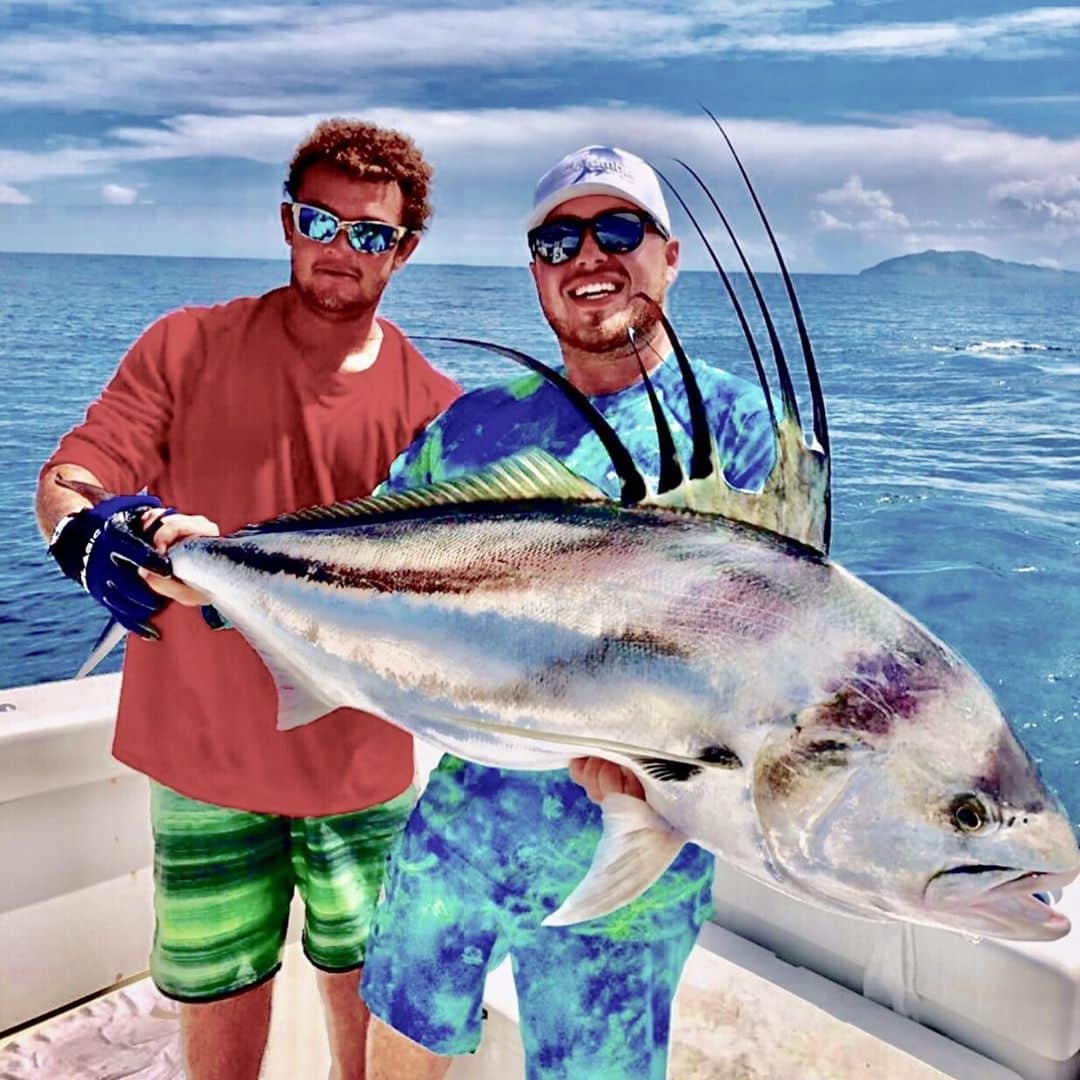
Roosterfish
In the North Pacific coast it can be found every month of the year, especially from October until March, it is common around the islands. In the Central Pacific coast it is common at river mouths, especially during the summer, from June to September. In the Southern zone large specimens of this species are seen throughout the year.
One of the most coveted catches in the world. Roosterfish is one of the most sought after by fishing enthusiasts as it is famous for the fighting capacity of this species. This is one of the strongest fish in the sea and getting a specimen to fish is a challenge, even for the most skilled fishermen.
Characteristics of the Roosterfish
The rooster fish is clearly identified thanks to its dorsal fin. It receives its name because, at the top of the fish, there are seven gigantic thorns that mimic the crest of the roosters.
One of the main attractions for fishing this species is its size. They have a great body that averages the meter and a half in length and nine kilos in weight. These size characteristics depend, to a large extent, on the areas where they are fished, they can reach three meters in length and an approximate weight of 20 kilograms. It is known that Panama can find larger specimens.
They are usually a bluish gray, white belly and resemble silver sometimes. Strips are usually distinguished, usually black, along its side or on the front of the head.
They have an elongated and large appearance, usually, although the body seems to compress on the front of the fish. The head is long and the mouth has an oblique shape. Inside the mouth, a row of small teeth protrudes from the jaw. In the lower part of the fish's oral cavity, we find 18 gill rakers, facing the twelve that are in the upper part.
The capture and release of this species is recommended, because it is a very popular objective in sport fishing. In addition, its flavor does not have great value in the kitchen.
Something that makes this particular spice is that it has an unusual disposition in the part of the ears. The swim bladder of these fish is introduced into the brain through a hole and contacts directly with the inner ear. This is very useful for amplifying sounds.
Where to find a roosterfish in Costa Rica?
This species is found mainly on shallow coasts of the Pacific Ocean, near areas of fine sand. It is usually around 900 or 1000 away from the shore.
Why fishing roosterfish in Costa Rica?
Costa Rica is really conducive to the capture of this coveted species because it has a wealth of natural resources and is considered one of the best environments for many other species.
The population of this fish is very large in the Costa Rican sea areas. The warm waters of this maritime area make the country's coasts a perfect place for sport fishing of this species. An area that stands out especially for fishing rooster fish in Costa Rica is Puerto Jiménez and its surroundings, in Puntarenas. Other points may be Isla del Coco, San Lucas or Tortuga Island.
Important notes about the Roosterfish
On the feeding of the rooster fish, due to its speed of movement, they can be allowed to hunt a great variety of species of different sizes.
Another factor to consider is the persistence of the rooster fish when it comes to keeping track of its prey, until it manages to catch and devour them.
Methods for catching Roosterfish
The rooster fish can be fished with different techniques such as:
Spinning
Spinning fishing is one of the most difficult modalities for catching rooster fish, but it is also one of the most exciting and rewarding. We can do it from the shore of the beach or from a boat. We must pay for a copy of these and throw the lure near it. His predatory character will quickly attack the bait, which will be the target of his fierce attack. From shore it is more complicated to carry out this type of fishing, especially if there is swell.
Trolling
This may be the most frequent because of the small boats that move around the roosterfish fishing areas. It is true that fishing for rooster fish with this modality presents a little less emotion than the previous one, but it is the most effective. With this technique we can find areas where the active specimens are located, where we can then apply other more lively fishing methods. You can also do bottom fishing at the points where we find the active fish.
Fly fishing
It is a modality that increases, little by little, its number of followers. What we must do is locate points where these fish are active. We will do this in places where we directly see rooster fish or after using the trolling technique. It is recommended that if we fish from the coast we use longer rods than if we do it from a boat.
